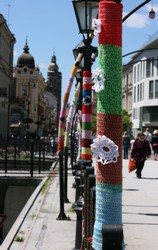Tibor Uhrín
Artists of all ages, genders and nationalities as well as amateur enthusiasts in the cities around the world knit, weave, crochet and “dress” columns, rails, fences, telephone boxes and other architectural details as well as trees and stones into their artworks. This non-aggressive form of art called by some knitted graffiti is a specific form of street art for which the majority of orthodox „graffiti artists“ have contempt. The art comes from Houston, Texas. However, the art soon became popular in our country and the name – knit (or crochet) graffiti or graffiti knitting won recognition quickly, too. In addition, Yarn Bombing (yarnbombing) is also a very accurate name, bombing in the graffiti terminology meaning a quick painting of many areas at a single territory.
In 2005, costume designer Magda Sayeg made a crochet costume of an exterior doorknob at her clothes shop in Houston. The idea was born. People around it formed a group and called themselves Knitta Please in 2005. The anonymous members of the group transferred traditional domestic craft of knitting and crocheting onto the streets. This type of art soon adopted various forms, starting from installations of knitted and crocheted objects and ending with the interventions in the land art-related country.
Despite the fact that Košice are going to be the European capital of culture as late as in 2013, the non-profit organisation team has been organising the Košice Interface 2013 project from 2008. Manager for community and art projects Christian Potiron has decided to launch graffiti knitting in Košice. His intention was to involve various interest groups and civic organisations into the project. Graduate of the graphic art and experimental work headed by professor Rudolf Sikora at the Arts Faculty in Košice Vlasta Žáková was the lecturer for the project. Members of all ages from various communities and associations worked under her guidance. They were instructed to “decorate” metal parts, rails, lamps and pillars of the bridge at Mlynská Street in v Košice. They finished the work on the project after one month. The results of the project were presented at the exhibition that was held at the end of May 2010.
